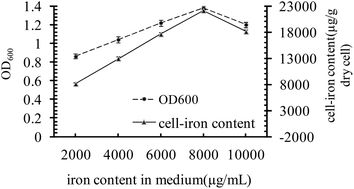Effects of Fe-YM1504 on iron deficiency anemia in rats
Abstract
Iron deficiency anemia (IDA) is one of the most serious forms of malnutrition. It is possible that some strains present in the natural environment possess a higher tolerance to inorganic iron and a higher ability to convert and accumulate iron compared with Saccharomyces cerevisiae wild-type strain. In the present study, the strain no. YM1504, able to grow in an iron-rich environment, was used as a potential organic iron supplement, and its efficacy in alleviating IDA in rats was investigated. Sixty female weanling Sprague-Dawley rats were randomly divided into a normal control group fed with a standard diet and a model group fed with an iron-deficient diet to create the IDA model. After the model was established, IDA rats were further randomly divided into five subgroups: the IDA group, the ferrous sulfate (FeSO4) group and Fe-YM1504 low-, medium- or high-dose groups receiving different concentrations of Fe-YM1504 supplements. Our results showed that Fe-YM1504 has an effective restorative function by returning the hemoglobin (Hb), hematocrit (HCT), mean corpuscular hemoglobin (MCH), mean corpuscular volume (MCV), serum iron (SI), total iron binding capacity (TIBC), serum ferritin (SF), etc. in IDA animals to the normal level. Moreover, malondialdehyde and the enzyme activities of superoxide dismutase and glutathione peroxidase in both plasma and liver homogenate were improved. Finally, compared with the FeSO4 group, the Fe-YM1504 middle-dose was more effective in alleviating IDA and fewer side effects were observed. The present study indicated that iron-enriched strain no. YM1504 might play a significant role in ameliorating IDA rats and might be exploited as a new iron supplement.


 Please wait while we load your content...
Please wait while we load your content...